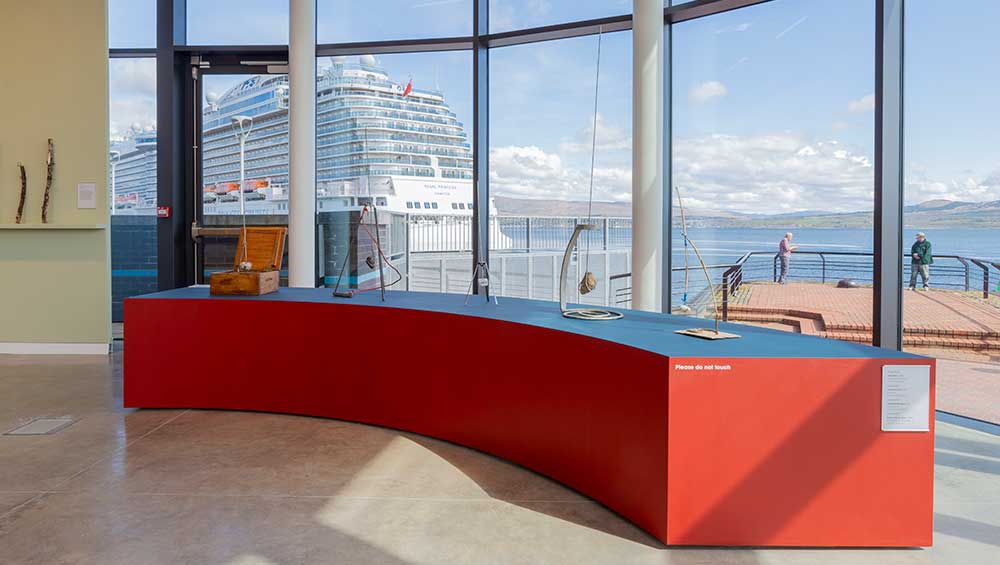
Installation view, The Wyllieum, Greenock. Photo: Sean Patrick Campbell.
The Wyllieum, Greenock
26 April – 1 September 2024
by BETH WILLIAMSON
George Wyllie (1921-2012) is a truly unique figure in the recent history of Scottish art, one whose singular view of the world is celebrated in a new gallery dedicated to his work and legacy – the Wyllieum in Greenock, situated on the edge of the river Clyde, less than 30 miles and a short train ride from Glasgow city centre. The sun was shining and the water was like glass the day I visited, a reminder of the area’s reputation as the Costa Clyde. Greenock’s history is steeped in shipbuilding. Although that’s long gone now, it remains a strategic working port for Scotland and a route to Ireland, America and Europe. Its Ocean Terminal regularly welcomes international cruise ships, and the Wyllieum, housed within the terminal, welcomes their passengers among its visitors, with others living locally or travelling from Glasgow and beyond. Importantly, it is close to Wyllie’s former home in Gourock and his place of work.
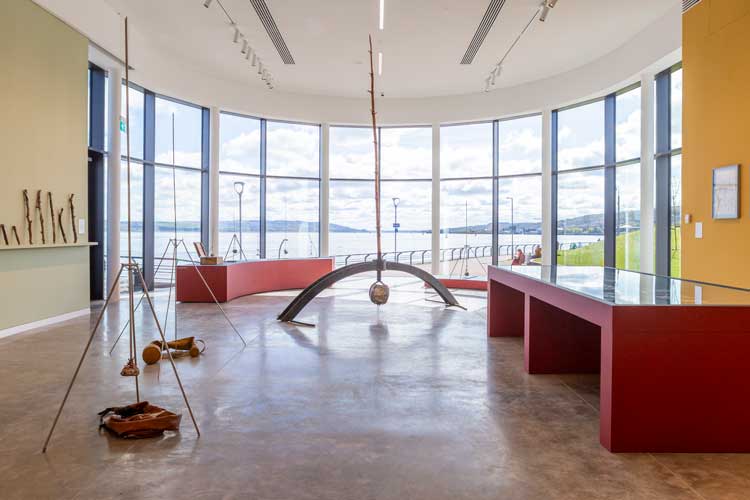
Installation view, George Wyllie: I Once Went Down to the Sea Again, The Wyllieum, Greenock. Photo: Sean Patrick Campbell.
Wyllie trained as an engineer with the Post Office and served in the Royal Navy (1942-46). He was one of the first foreign nationals to visit Hiroshima shortly after America dropped the atomic bomb, a harrowing experience that, understandably, stayed with him his whole life. He worked as a customs and excise officer in the docks for 30 years before becoming a full-time artist in his late fifties. In 1965, he made 10 sculptures under his “Ten Object Plan”, deciding that if he was happy with at least one of the 10, he would focus entirely on making art. That is how it began. His experiences of the second world war, as well as the socialist principles of shipbuilders, dock workers and the river economy he encountered while working in customs and excise, remained the driving force behind his strong sense of social justice and equality and fed into his making.
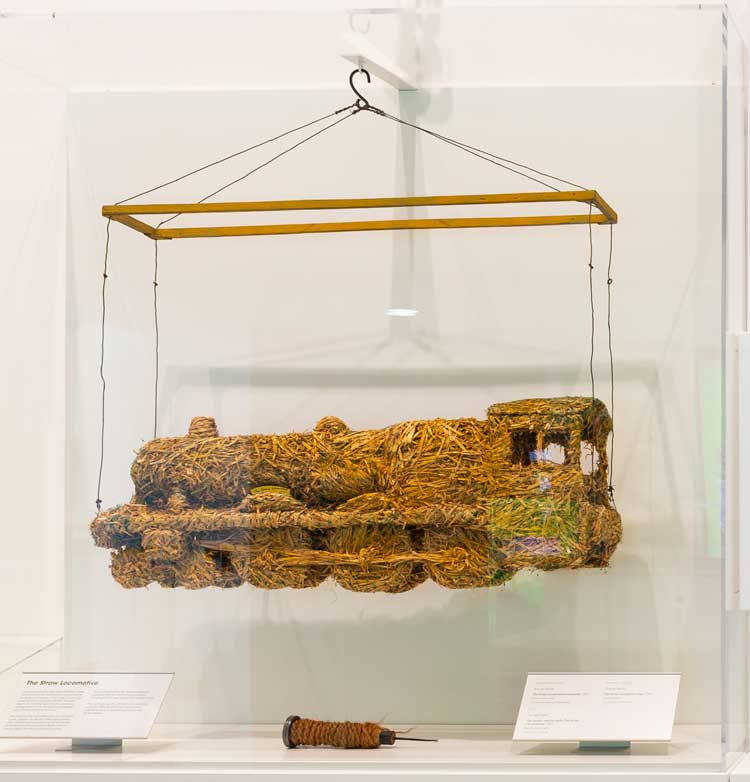
George Wyllie. The Straw Locomotive, 1987. Installation view, The Wyllieum, Greenock. Photo: Sean Patrick Campbell.
Wyllie’s career is proof that positive change can come at any point in our lives, and his passion was no less because of his late start. Best known for his off-the-wall public sculptures The Straw Locomotive (1987) and The Paper Boat (1989), these two sculpture-performances that told the story of the river in decline still loom large in the Scottish psyche. Yet, Wyllie’s artistic practice, largely self-taught and self-made, was about much more than these two works – monumental in scale but anti-monumental in every other respect.
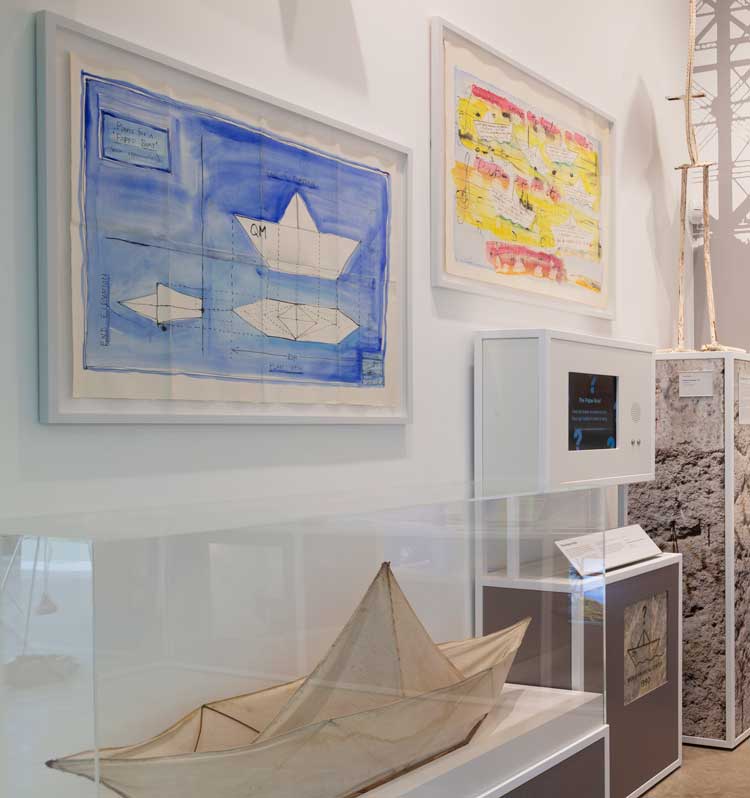
The Paper Boat, 1989. Installation view, George Wyllie: I Once Went Down to the Sea Again, The Wyllieum, Greenock. Photo: Sean Patrick Campbell.
The first thing you encounter in the Wyllieum is its permanent collection – Wyllie’s story in a nutshell, if you like, complete with art works, archive, ephemera and films. It’s a great introduction to the man and his work, giving a real flavour of his loves, hates and eccentricities. There is a happy atmosphere here – and so there should be. Wyllie’s work is worth celebrating. In one film, he demonstrates his mechanical sculpture Machine for Applauding Paintings (with Critic’s Thumb Attachment) (1976), which now sits in the foyer ready to be wound up into action. It’s a great sentiment, but it is also amusing, and as arts journalist Jan Patience has said, he was a seriously playful artist.
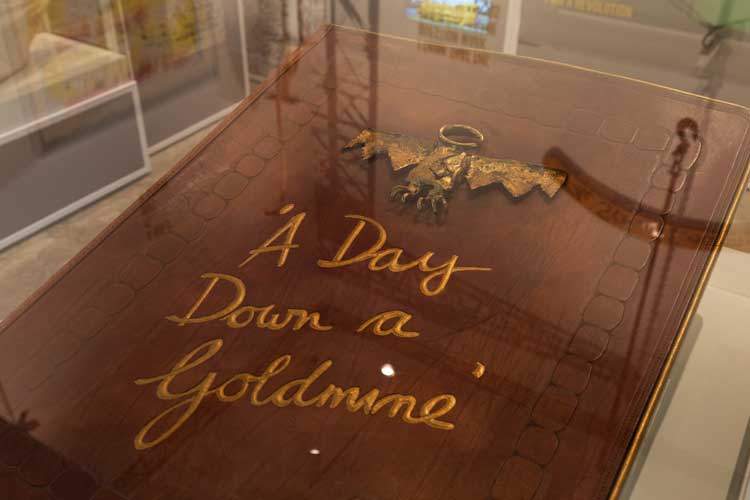
A Day Down a Goldmine, 1982. Installation view, George Wyllie: I Once Went Down to the Sea Again, The Wyllieum, Greenock. Photo: Sean Patrick Campbell.
From the vantage point of the present day, Wyllie’s work was visionary. His sculpture A Mortgage Climbing the Wall (1965) is eerily prescient of some of today’s housing problems. He was prophetic, too, of the inequalities in the banking system in his play A Day Down a Goldmine (1982). In 1986, his reflections on his experience of visiting Hiroshima are of course traumatic: “The absurdity, the horror, and the difference of Hiroshima is that for the first time ever, the evolution and eternity of this planet and its human race, and the culmination of all energies which is fertility, can be converted, by a touch on an idiot switch, to sterility.”1 Yet, they also echo an ecocritical discourse, seen again in his work The Original Earth Guarantee (1982), before such a thing existed. Late works focused on the environment and attaining equilibrium or balance in nature.
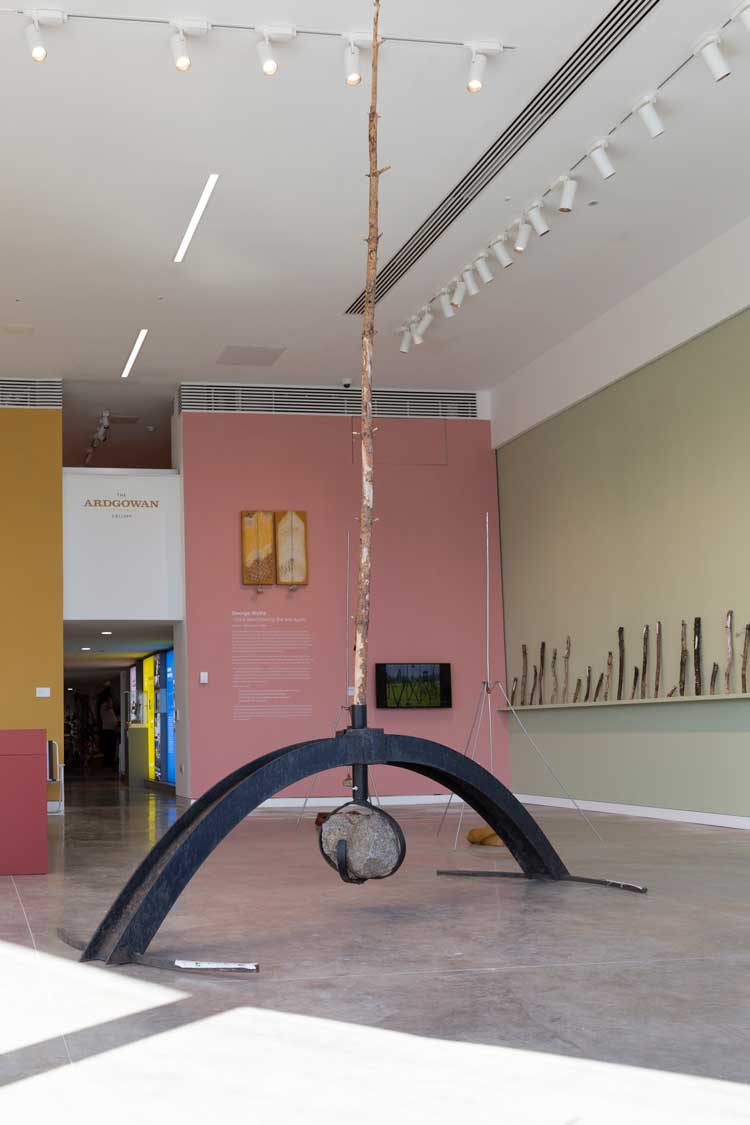
Installation view, George Wyllie: I Once Went Down to the Sea Again, The Wyllieum, Greenock. Photo: Sean Patrick Campbell.
Another space in the Wyllieum, awash with floor-to-ceiling windows and flooded with light, is set aside for temporary exhibitions, the first, now on show, is George Wyllie: I Once Went Down to the Sea Again, co-curated by the gallery’s director Will Cooper and the sculptor Sara Barker. This focuses on Wyllie’s sustained practice of making his sculptural series Spires (1982-2007). Wyllie began making his spires (simple works made of a vertical rod or pole, supported on a base and counter-balanced with a stone) in 1982, the year after he first met the German artist Joseph Beuys. There are many variations to these works, and this exhibition does well to display a wide selection, accompanied by related drawings and archival material. It’s a joy to see and really allows visitors to develop a deeper understanding of what he was about. The fundamental idea behind the spires was to focus attention on everyday encounters with people, places and events. As Wyllie explained: “The spire is designed to celebrate the place on which is stands. Beyond that, its importance is of no importance. It can define any space or presence taken for granted and signify them important.” No pomp, no ceremony, just simple celebration of the quotidian in time and place.
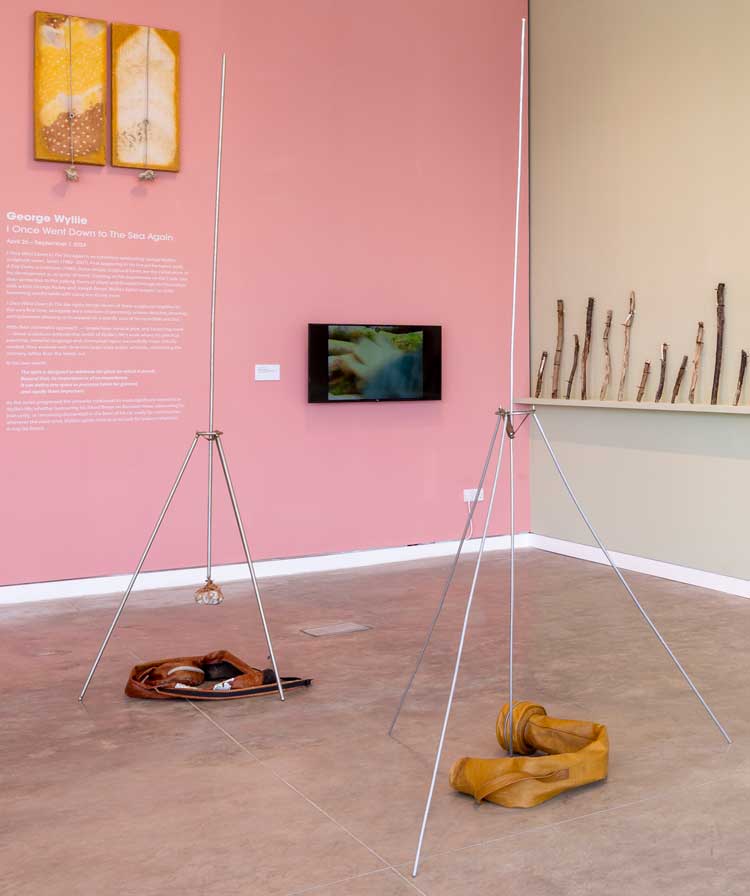
Foreground: Portable Spire I and Portable Spire II, both 1984. Installation view, George Wyllie: I Once Went Down to the Sea Again, The Wyllieum, Greenock. Photo: Sean Patrick Campbell.
Wyllie even made portable spires (Portable Spire I and Portable Spire II, both 1984), which he kept in modified golf bags in the boot of his car, ready to be assembled and erected at the side of the road should he encounter a scene worthy of a moment of celebration.
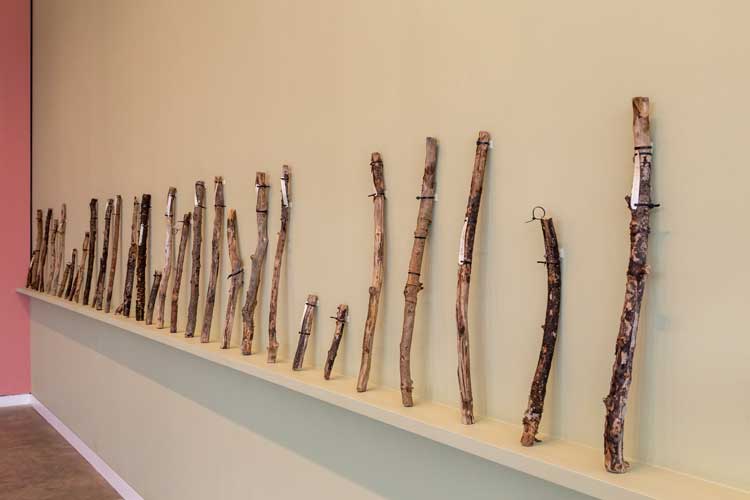
Thirty-Two Spires for Hibernia, 1994. Installation view, George Wyllie: I Once Went Down to the Sea Again, The Wyllieum, Greenock. Photo: Sean Patrick Campbell.
Thirty-Two Spires for Hibernia (1994) originally consisted of a monumental arrangement of 32 spires, each one made from wood and stone, collected from the 32 counties of a united Ireland. It was displayed across the border between Northern Ireland and the Republic of Ireland and called for peace. What is shown in this exhibition are the remnants of these 32 spires, displayed together. Wyllie later made spires to mark Rannoch Moor (Beuys’s favourite place in Scotland) and to enhance his garden studio.
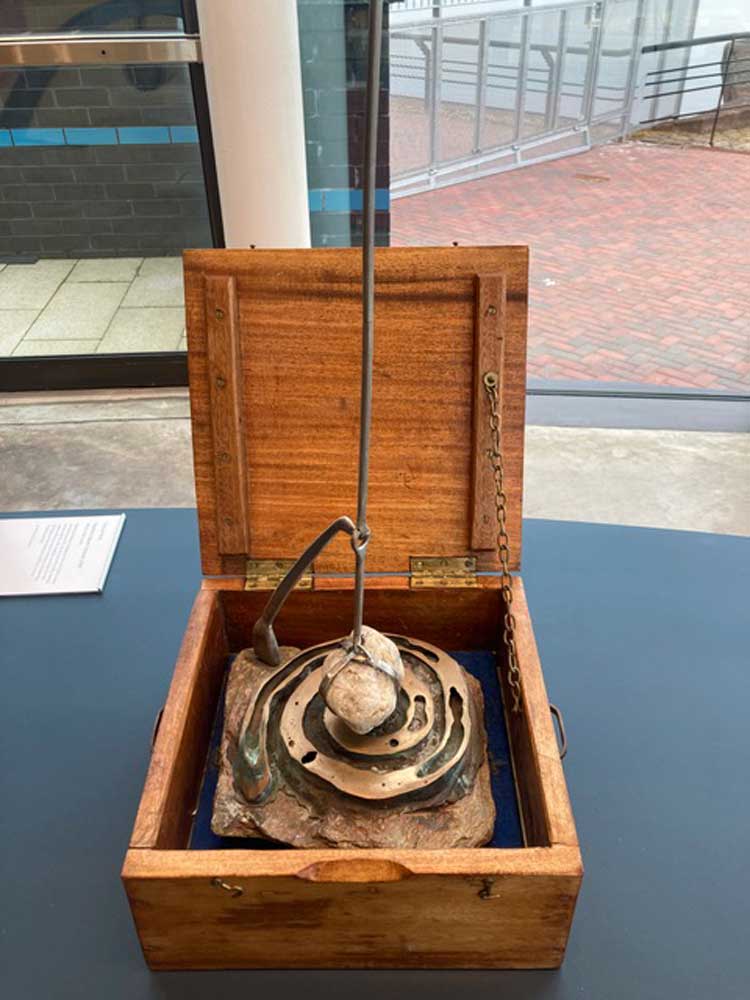
Daphne’s Happy Compass, 2004. Installation view, George Wyllie: I Once Went Down to the Sea Again, The Wyllieum, Greenock. Photo: Beth Williamson.
Surely the most poignant and personal work in this show is Daphne’s Happy Compass (2004). When his wife Daphne was ill at the end of her life, he visited her in hospital every day for two years and assembled the spire next to her to aid balance and help her on her cosmic journey. His commitment to Daphne was unwavering, as was his commitment to his art.
Wyllie’s legacy has been secured in the form of the Wyllieum. As well as the gallery space for permanent and temporary exhibitions, there is a developing creative space and emerging archive space, all ripe for development in initiatives that will engage students, contemporary artists, local residents and any number of different audiences. It feels like an inclusive cultural space, a hopeful space for the future and a space that will give a whole gamut of people access to Wyllie’s art and ideas. Just as he made time for art in his life, it certainly is time for art in Greenock and Inverclyde.
References
1. George Wyllie quoted from 1986 in exhibition wall text at the Wyllieum.